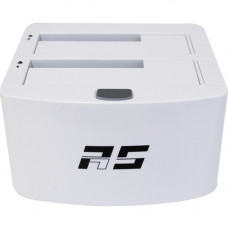Shopping Cart
0 item(s) - $0.00- Accortec, Inc.
- Addon Tech
- Advantech Co., Ltd
- Axiom
- BLACKBOX
- C2g
- Chief Manufacturing
- Cisco
- Dell
- EATON
- EMC
- Enet Components, Inc.
- Fortinet
- Getac, Inc
- HP
- HPE
- IBM
- Intel
- Legrand Group
- Lenovo
- Lexmark
- Middle Atlantic Products, Inc
- Monoprice, Inc
- National Products, Inc
- Panduit Corp
- StarTech.com
- Supermicro
- TDK
- Tripp Lite
- Veritas Technologies Llc
HighPoint RocketStor 3112D Drive Dock SATA/600 - USB 3.2 Type C Host Interface - UASP Support External - 2 x HDD Supported - 2 x SSD Supported - 2 x Total Bay - 2 x 2.5"/3.5" Bay RS3112D
Part Number: RS3112D
MSRP: $171.99
Availability: 10 or more
Condition: New
Add to Compare
Dual-Bay 10Gb/s USB 3.2 to SATA Drive Dock The RocketStor 3112D is a USB 3.2 10Gb/s drive dock with dual dedicated SATA drive bays, and a single USB Type-C host connector. The two independent drive bays provide dedicated bandwidth and resources for each hosted SATA SSD or hard disk. Key Features Universal 10Gb/s USB 3.2 Type-C port works with any USB 3.x or Thunderbolt Type-C host connection Dedicated SATA Channels enable simultaneous access to both drive bays Supports 2x 3.5"/2.5" SATA HDD or SSD Plug & Play Installation UASP Enabled Windows, macOS & Linux compatible Indepedent Bandwidth & Dedicated Resources for Each SATA Device Unlike most drive docks in today''s marketplace, each of the RocketStor 3112D''s drive bays operate independently; hosted SATA devices can be accessed either concurrently or separately as the need arises, without fear of performance loss or a drop in response time, even under heavy I/O. Universal Type-C Connectivity The single, 10Gb/s USB Type-C port was designed for use with HighPoint''s USB-C31-1MC 1 meter USB-C to USB-C cable. This combination enables the drive dock to be used with any industry standard USB 3.x or Thunderbolt Type-C port. User Friendly Plug and Play Installation Setting up the RocketStor 3112D could not be easier. No Driver or Software is required; just plug in and power on! Each drive bay is Hot-Swap ready - your system will automatically recognize any disk you insert. Compact and Easy to Use A single RocketStor Storage Dock requires a minimal amount of physical workspace, yet is capable of supporting the fastest 6Gb/s SSD''s and ultra-high capacity hard drives, simultaneously. The open-topped, vertical device bays allow you to use any generation of 2.5" and 3.5" SATA SSD & hard drive, of any capacity and performance level. True USB Hot-Plug capability allows you to add or remove any disk on the fly, at any time, risk free. UASP Enabled: Maximizing the Performance Capability of USB Devices UAS (USB Attached SCSI) is a computer protocol that is used to transfer data to and from USB storage devices. UAS offers maximized bandwidth utilization, and can handle multiple data transfer requests simultaneously, unlike the slower queue system of BOT (Bulk Only Transport), which only provides single-task commands - each task must complete before the next begins. USB connections working in UASP mode result in higher transfer speeds and lower CPU utilization. UASP mode results in higher transfer speeds and lower CPU utilization.
Write a review
Your Name:Your Review: Note: HTML is not translated!
Rating: Bad Good
Enter the code in the box below:


